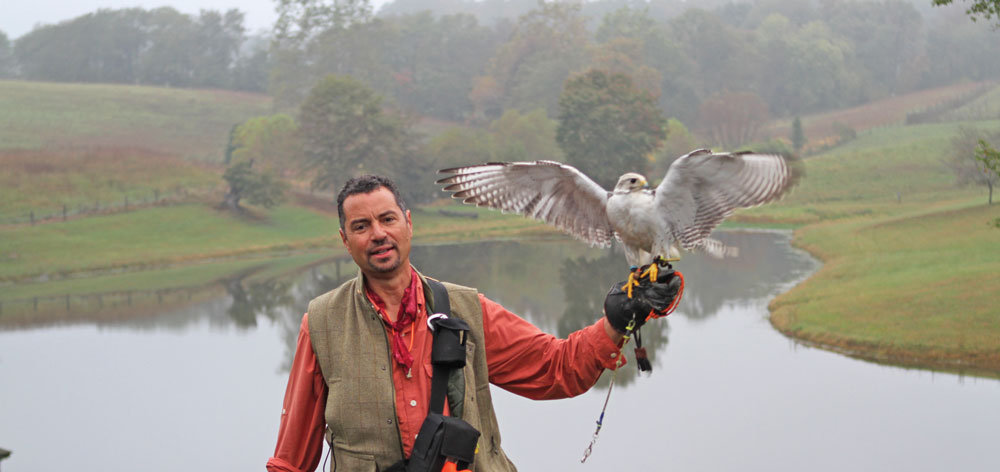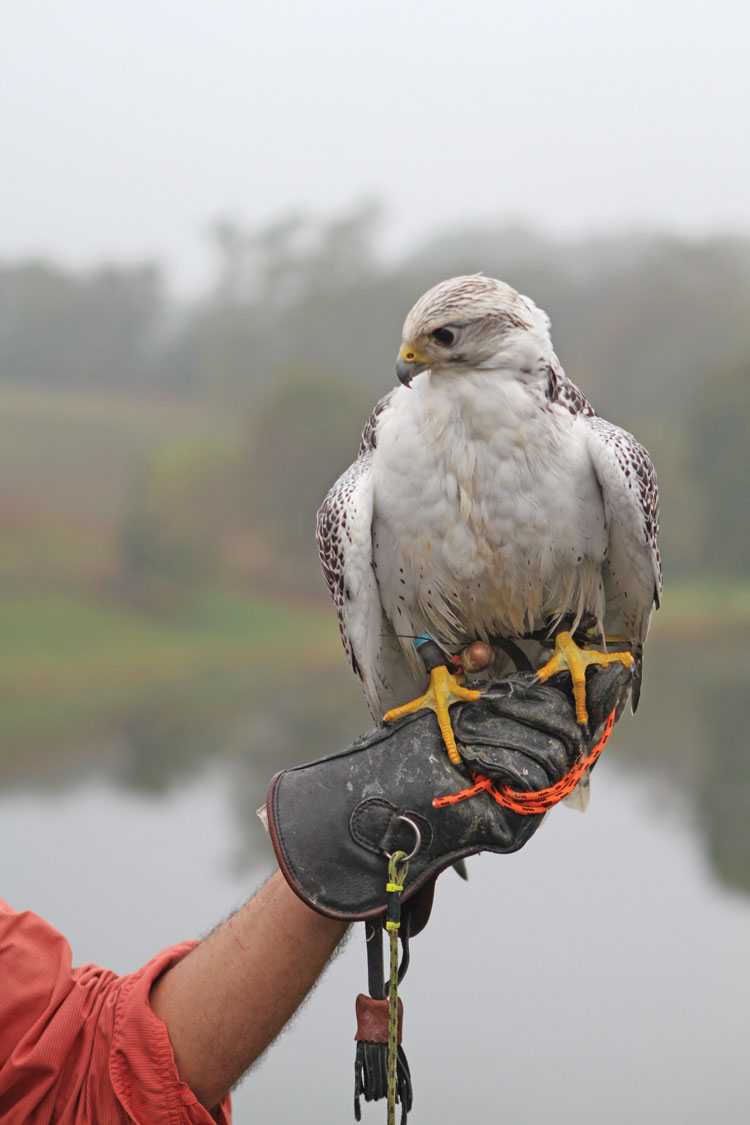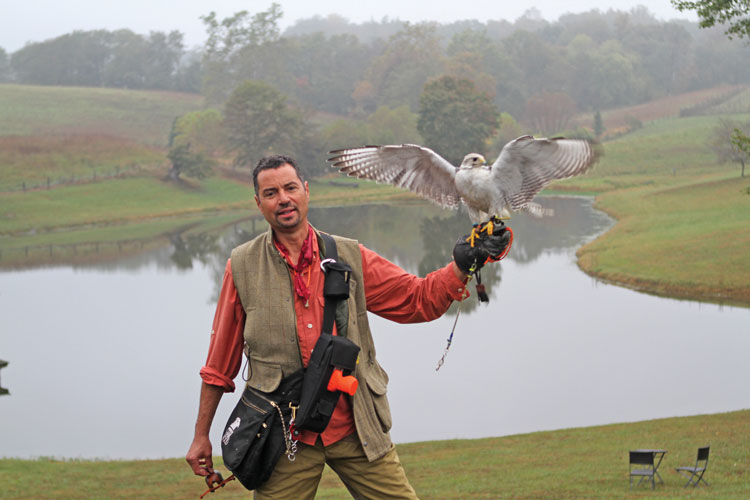Mike Dupuy: Enter the World of Falconry

Story and photos by Elaine Anne Watt
You may have been one of those children who fell in love with the book, “My Side of the Mountain” by Jean Craighead George. A right of passage for many of us, this story tells of a boy and his falcon surviving on a mountain in the Catskills of New York. Unlike others, Mike Dupuy remembers it as the pivotal inspiration for turning his lifelong fascination with birds into a “materialized dream” of becoming a falconer.
Haitian born and having moved to New York when he was 5, Mike’s father and stepmother encouraged his interest through hunting and fishing trips in the Catskills and by arranging for Mike to meet prominent scholars and advocates for wildlife. He credits none other than Dr. Heinz Meng, the scientist who successfully bred peregrine falcons in captivity and reintroduced them into the wild after their existence was threatened by the pesticide DDT, as one of the most influential people in his life.

Mike recalls that he started telling people at age 9 that he was going to be a falconer, and he trapped his first bird at age 16 soon after he’d gotten a car. In Haiti, birds of prey were called “mal-fini,” meaning “bad end.” But that is a bad rap for a raptor. They are simply doing what comes naturally, and the sport of falconry is thousands of years old and an art form that has amazing parallels to the equestrian world.
After many years as a hard-driving sales professional in the top echelons of a Fortune 50 company’s team, Mike could no longer resist the lure of his real love. Now living in Pennsylvania after years in the D.C. area, he has turned his entrepreneurial spirit into three thriving businesses, Mike Dupuy Falconry, where he teaches and lectures on the Art and Sport of Falconry, Mike Dupuy Hawk Food, and Mike Dupuy Media Services, a company dedicated to capturing the stories of falconers and raptors. These businesses allow him the privilege of working with these incredible creatures and sharing his knowledge with others.
Anyone can try to be a falconer, but to develop the symbiotic relationship to do so successfully is a craft to be honed carefully. Mike describes a highly nuanced process of adapting the bird through positive reinforcement to trained behavior. He emphasizes the trained rather than the tamed, because falcons and birds of prey are never stripped of their wild nature. So beware your heart if you dare to consider them your pet. Theirs is not the loyalty of a domesticated animal; think of yourself instead as their meal ticket and sugar daddy. You provide them the filet mignon on their schedule or they may well fly away at their next opportunity. “A great day is when you simply get the bird back on your fist,” said Mike.
But, before we talk about the process, let’s first address some of the fallacies surrounding the sport. It is not cruel. Falconry is highly regulated, requiring licensure and adherence to complicated state and federal rules. Seventy to 90 percent of hawks die in their first year of life in the wild, whether they are caught in wires, killed while hunting or just as a result of the survival of the fittest. Only the best hunters make it through the winter, and a 12-year-old raptor would be incredibly rare in the wild. In captivity, they can live to be 30, and one of Mike’s birds laid an egg at age 24. They need to eat almost daily, storing their food in their crop where it is slowly absorbed until only the hair and sometimes bones remain to be spit out as pellets. The phrase “I’m fed up with you” comes from falconry as does “you’re looking haggard,” the appearance of falcons after they mature to adulthood and molt. Besides the legal imperatives to be responsible handlers, falconers are self-policing, holding themselves to highly ethical standards.
So, how does one become a falconer? You need to be taught the skills to first trap your bird and then engage it in the dance of getting to know one another and adapting to the cues that will forge a bond.
Mike says, “I don’t pretend that I have a personal relationship with the bird, but I hone in on the signals it is sending me. Whether it likes you is irrelevant.”

If this sounds heartless, you couldn’t be more wrong. Mike loves his birds unconditionally; he just recognizes that their allegiance is to what he provides, not to his feelings for them or theirs for him. He recounts the story of when he brought his friend, British falconer Jemima Parry-Jones, to meet Barbara DuPont at her home here in Hunt Country during a Virginia Falconers Association event. On their way through Maryland, his Goshawk failed to return to him during a stopover there. They waited as long as they could, but they had to get to Virginia that evening. The next morning, Mike and his wife Christine hurried back to Hunt Valley, Maryland, following the signal being transmitted from Nevada, a bird they had raised from a baby. They weren’t hearing any bells indicating movement, and their worst fears were confirmed when they found what was left of “their baby” under a bush having been eaten by a resident Red-tailed hawk. He admits to a good deal of “blubbering” thereafter.
Mike shared another particularly close affection for Cinnamon, a Red-tailed hawk immortalized by National Geographic. He said one of his best days was when she caught a squirrel, a rabbit and a pheasant within a 24-hour period. One of his worst days was when he lost her. Cinnamon helped teach him “a humbleness of heart that if anything goes wrong, it’s my responsibility.”
In falconry, you must be sponsored by either a General or Master Falconer and serve an apprenticeship. Beginners start out by trapping a Kestrel or Red-tailed hawk. Using a rodent or pigeon as bait, Mike calls this “sky-fishing,” as you attract the hawk to the bait which is wearing a vest with nooses that entangle the hawk. The hawk will flip on its back in order to defend itself, giving you the opportunity to pick it up and hood it. Within 15 minutes of being hooded, the hawk will become totally calm. Those first 24 to 48 hours, however, are difficult as the predator has become the prey. Eventually the bird realizes that it hasn’t been harmed, and then you can start tempting it with food. The moment the bird looks down to eat, Mike blows a whistle, beginning the association of the whistle with food that will become the foundation for training.
Mike refers to “operator error.” If something goes wrong at any point in the training, it is his fault. “I’m supposed to stay out of the way, to nurture and shape the bird to be its best possible version of its natural self in the wild,” he says.
An important part of the training process is identifying the bird’s “flying weight,” which is the weight at which the bird is hungry enough to return to the falconer on command. If a raptor is over its “flying weight,” it is considered “fat.” A bird that is “fat” does not need food, so it will not be responsive to training techniques. If a bird is under its “flying weight,” it is “too low” and won’t have enough energy to fly. At the beginning of each training session, Mike weighs and records the bird’s weight. He then observes and records the bird’s behavior during the session and whether it was responsive to training or not.
Through a Pavlovian response and reward system, the raptor is trained on a leash to get further and further from the fist and back, to a perch, to a tree line and back, etc. until you’ve reinforced the behavior necessary for the sport. And Mike finds honesty and beauty in the process.
“They take no pleasure in the kill,” he says. “They are doing what they were born to do. They kill only to eat and feed their babies. Nothing is wasted, and they keep a lot of animals in check through their activities.”
Mike has shared a ten-plus year friendship with Jim Fowler, co-host of the original Mutual of Omaha Wild Kingdom, as well as many other personal and professional relationships forged through his love of falconry and the out-of-doors. So what motivates him to continue his work? Two things. He recognizes that “there is always more to learn and room to grow, and there is nothing you can conceive in your mind that can make it as real as doing it. It grounds you in a life and death way that will shape you.” Secondly, “I want to take public speaking to a larger platform to share culture through the lens of a falconer.”
To watch Mike interact with his birds is fascinating. And, to watch them take flight is breath-taking. To see them return seems miraculous. Another natural wonder. ML

If you want to learn more, Mike suggests: Visit: http://themodernapprentice.com, a website by his friend, Lydia Ash. Read: “A Rage for Falcons,” one of his favorite books that gets readers into the head of a falconer, by Stephen Bodio. Consult: http://www.mikedupuyfalconry.com/falconry/how-to-get-
started-in-falconry Visit www.mikedupuyfalconry.com; or call 570-837-1551.


